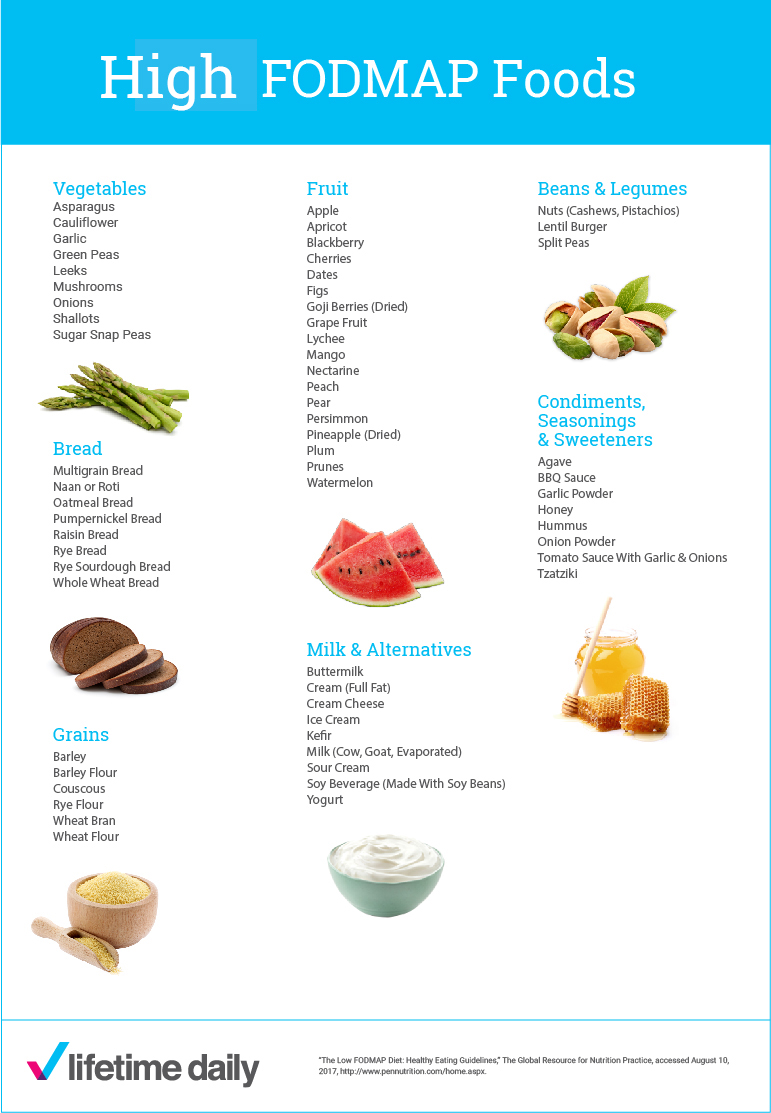Irritable bowel syndrome (IBS) is traditionally considered to be a condition that affects young and middle-aged adults. How the disorder manifests in the 50-plus population remains unclear. But increasing evidence suggests that prevalence of IBS in older adults may be similar to that in younger adults, with 10-20% of older adults experiencing symptoms.

What Are FODMAPs?
FODMAPs are the names for different types of carbohydrates found naturally in everyday foods such as fruit, vegetables, grains, beans and milk products. Research shows that a diet low in FODMAPs can help reduce the symptoms of irritable bowel syndrome (IBS). Typical symptoms of IBS include gas, bloating, abdominal pain, diarrhea or constipation.
The term FODMAP stands for:
The Letter F
Fermentable (which means “broken down” or fermented by the bacteria in the large intestine).
The Letter O
Oligosaccharides (e.g. fructans – the type of carbohydrates found in grains such as wheat, spelt, rye and barley; e.g. galactans – the type of carbohydrates found in beans and legumes).
The Letter D
Disaccharides (e.g. lactose – the type of carbohydrate found in milk and milk products).
The Letter M
Monosaccharides (e.g. fructose – the type of carbohydrate found in fruit such as apples and pears, as well as in honey).
And…
The Letter P
Polyols (e.g. xylitol, sorbitol, maltitol and mannitol – these are types of sugar alcohols found in some fruits like apricots and cherries; they’re also often used as sweeteners in sugar-free gum/candy/mints/ cough drops/cough medicines).
How the FODMAP Elimination Diet Works
The FODMAP Elimination Diet is also called the Low FODMAP Diet. Most of the food and drinks we consume is digested and absorbed in the small intestine. But some people have trouble digesting FODMAP foods (see a FODMAP food list below).
When this happens, the FODMAPs move on down into the large intestine and become food for the bacteria that live there. The resulting gas, bloating and flatulence occur as the bacteria break down and ferment the FODMAPs in the large intestine. FODMAPs also draw water into the large intestine, contributing to bloating and diarrhea.
Stage 1 of the FODMAP Elimination Diet
For six to eight weeks, all high FODMAP foods are eliminated from the diet. Not all high FODMAP foods will trigger symptoms in all IBS patients. It’s important to consult with a Registered Dietitian to figure out which foods may be problematic for you and also to ensure that you’re not lacking any nutrients during the elimination diet.

Stage 2 of the FODMAP Elimination Diet
After eight weeks, some high FODMAP foods may be slowly re-introduced, one at a time, so that you can see which foods trigger IBS symptoms. The types and amounts of FODMAP foods tolerated will vary from person to person.
Diabetes and the FODMAP Elimination Diet
Carbohydrate foods play an important role in managing both IBS and diabetes. In diabetes, carbohydrate-containing foods are broken down into glucose, affecting blood glucose (blood sugar) levels. Many low FODMAP fruits and vegetables can be included if you’re following a diet for diabetes. However, some sugar-free foods are high in FODMAPs and can trigger IBS symptoms. It can be confusing and overwhelming to figure out which foods are okay for you to eat. Talk to a Registered Dietitian for a personalized diet plan.
Low Versus High FODMAP Foods
Here is a list of common foods that are low in FODMAPs. Consult with a Registered Dietitian for a more detailed FODMAPs list.




